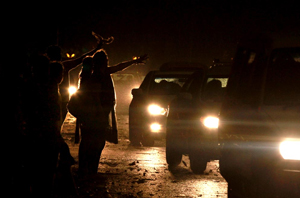New Delhi, May 31: At least nine people were killed in the NCR region, including six in Delhi, as a massive thunder storm lashed the region crippling road traffic, metro services and flight operations and hitting power supply.
 Delhi Police said six people died and 13 were injured in various areas of the city in accidents like felling of trees, collapse of walls and electrocution following the storm which was accompanied by winds at a speed of over 90 kmph.
Delhi Police said six people died and 13 were injured in various areas of the city in accidents like felling of trees, collapse of walls and electrocution following the storm which was accompanied by winds at a speed of over 90 kmph.
he storm struck Delhi at 4:58 pm immediately throwing normal life out of gear.
Thousands of people were stranded outside Metro stations and on roads as traffic almost came to a halt due the storm which darkened the sky.
Most areas in city plunged into darkness immediately after the storm as uprooted trees snapped power lines. Metro train services were disrupted on almost all lines for about an hour due to power failure during the evening rush time.
Met department termed the storm as "cumulonimbus" andattributed it to western disturbance over Pakistan. NCR areas of east Delhi, Noida and Ghaziabad were most affected by the storm.
Met office said similar weather conditions are likely to persist for over the next two days. At least 12 flights werediverted due to the storm, an IGI official said.
Areas in South, East and North Delhi faced long power cuts ranging from one to four hours. Supply of power could not be restored till late in the evening in several areas in North and North West Delhi.
The city saw massive traffic jams as the storm uprooted trees snapping power lines in many areas and affecting traffic lights leading to chaos on the streets.
"The cumulonimbus brings tall thunderstorms and dusty winds with a speed of over 92 kmph and are caused because of western disturbance, which is currently over Pakistan."
"The meeting of cold air and hot air on the Indo-Gangetic plains causes low pressure area and also lot of instability. This results in severe thunderstorm," IMD Director General L S Rathore said.
The storm affected northeast Haryana and the NCR. But parts of east Delhi, Noida and Ghaziabad were affected the most, he said.
Police in Ghaziabad said the storm claimed three lives and injured more than a 12 people besides causing heavy loss to property in different parts of the city.
"This phenomena is likely to continue for the next two days," Rathore said.
The maximum temperature recorded today was 42.8 degree Celsius while the minimum was 29.1 degree.
At some locations including Janakpuri and Inderlok, material like tin sheet and pipes got entangled into the overhead electrification wire due to the dust storm, making train movement impossible.
The storm affected many transmission lines and power generation plants in Delhi.
"A maximum load up to around 3000 MW was affected. The lines which tripped included lines of both northern grid as well as of Delhi Transco," said a senior Power department official.
Power generation plants Rajghat power house, Pragati Power Station and three units of BTPS also tripped.
Delhi Police said a 17-year-old youth, identified as Anu died when a tin sheet slit his neck and then hit his 51-year-old mother's on her head leaving her critically injured in Vivek Vihar area in east Delhi.
Five people were injured in East Delhi in a wall collapse.
In South West Delhi, two people including an 18-year-old girl were killed. The Class XII student lost her life after a portion of a boundary wall fell on her around 5.15 pm.
The girl was identified as Aasha Malik and she was returning home after tuition classes. She was shifted to Rao Tula Ram Hospital where doctors declared her dead on arrival.
Three people were injured in North East Delhi while another trio were injured in Nizamuddin area in South East Delhi.
In Central Delhi, a 24-year-old cab driver, identified as Chattarpal died after a tree fell on his car in I.P. Estate area around 5.30 pm.
In North Delhi, a man identified as Younis was killed after a tree fell on him. A 20 year-old-youth was killed when a tree fell on him in Uttam Nagar are of West Delhi, police said.
The MeT department has also predicted bad air quality in the city for the next three days.
System of Air quality Forecasting And Research (SAFAR), a constituent of Indian Institute of Tropical Meteorology, said the air quality was found "poor" following the storm.
Parked cars were damaged in some areas due to felling of trees.
In North Delhi, at least nine complaints of tree or its branches falling were received by the North Corporation from its various zones, NDMC Public Relations Officer Yogendra Singh Mann said.
"The control room of North Delhi Municipal Corporation received nine complaints of falling of trees or branches. While three complaints each were received from Civil Lines Zone and City Zone areas, two complaints came from Rohini Zone and one from Narela Zone," he said.
East Delhi Municipal Corporation received the maximum complaint of 20 such cases. While six complaints were received from Shahdara (North) Zone area, the remaining 14 complaints came from Shahdara (South) Zone, Mann said.
However, no casualty has been reported so far, he said, adding, couple of complaints of water logging were also reported.
In South Delhi, a total of 11 cases of fallen trees were reported.
"Four trees fell in South Zone, three each in Central and West Zones while one in Najafgarh Zone," SDMC Public Relations Officer Mukesh Yadav said.





Comments
Add new comment